Note: This publication is currently undergoing major revisions. The current publication will be replaced with a new publication based on stakeholder requirements and scientific advances. We expect to begin sharing details on this soon. If you have input on content, format, or publication frequency at any time, please contact us at cbrfc.webmasters@noaa.gov.Lower Colorado Water Supply Outlook, March 1, 2009Lower Colorado Water Supply Outlook, March 1, 2009
Contents
Lower Colorado Summary
Below average precipitation occurred over much of the Lower Colorado region with the exception of
the middle and lower Salt River Basin, and extreme western Arizona during February. Very
warm temperatures during the latter half of the month resulted in a loss of snowpack below
9000 feet which increased streamflow volumes in the Verde, Salt, Tonto, and Little Colorado
drainages. No significant precipitation events are anticipated during the first part of March
in the Lower Colorado Basin with the period beyond March climatologically drier than the
winter period. Seasonal streamflow volumes are generally expected to be below median for the
March through May period.

*Median of forecasts within each basin.
Salt Basin Conditions
Model Soil Moisture/Observed Streamflow - Streamflow in February ranged from near 120 percent
of median on the Salt River to near 215 percent of median on the Verde mainstem. Lower elevation
snow melt contributed to the streamflow volumes and river responses were indicative of moist soil
conditions in this area.
Snowpack/Precipitation - Below to near average precipitation occurred during February in the upper
Salt River Basin with near to slightly above average precipitation in the Tonto and Verde Basins.
Seasonal precipitation, October through February, was near to above average. Snowpack conditions as of
March 1st were quite variable in the Verde, Tonto, and Upper Salt River drainages and ranged from near
50 to 160 percent of average at individual measuring sites.
General Discussion/Forecasts - Near record warm temperatures during the latter half of February
resulted in enhanced snowmelt and a reduction in the areal coverage of the snowpack. Snowmelt is
expected to contribute to above median flows on the Salt River through the first two weeks of March.
Elsewhere only a minimal contribution to streamflow volumes is expected from the remaining snow.
Seasonal forecast volumes for the March through May period range from 60 to 85 percent
of median.
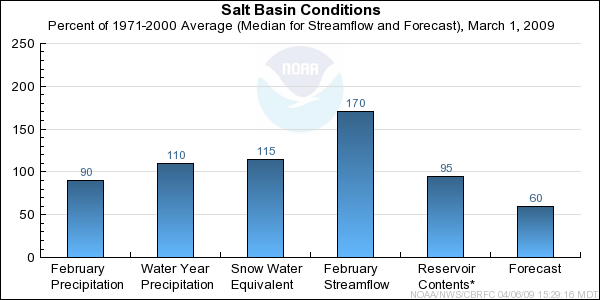
* Percent usable capacity, not percent average contents.
Click for multi-month Graph.
Gila Basin Conditions
Model Soil Moisture/Observed Streamflow - Streamflow volumes for February in the upper Gila River
Basin were near 50 percent of median. Seasonal flows dating back to October have also been below
median and in combination with below average precipitation suggest soil moisture deficits exist in this
area.
Snowpack/Precipitation - Precipitation in the upper Gila Basin was much below average for February. With
the exception of December, monthly precipitation has been below average each month dating back
to October of 2008. Seasonal October through February precipitation was near 70 percent of average.
Snowpack in the Gila Basin has been depleted with minimal amounts remaining at highest elevations.
General Discussion/Forecasts - Seasonal volume forecasts in the Gila Basin reflect the dry conditions
that exist in the Basin. March through May runoff volumes are forecast to range between 30 and 45 percent
of median.
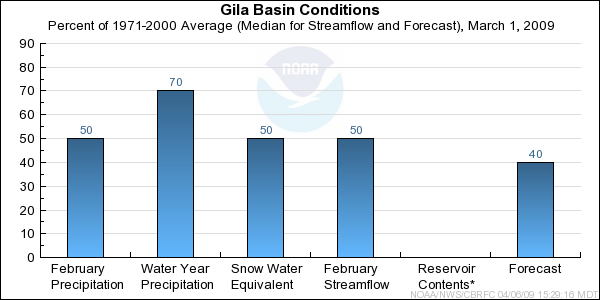
* Percent usable capacity, not percent average contents.
Click for multi-month Graph.
Little Colorado Basin Conditions
Model Soil Moisture/Observed Streamflow - Streamflow volumes for February varied quite dramatically
in the Little Colorado tributaries due to snowmelt below 9000 feet. Some small higher elevation
streams experienced volumes in excess of 100 percent of median while mainstem Little Colorado volumes were
in the 60 to 90 percent of median range.
Snowpack/Precipitation - Precipitation in the Little Colorado drainage was near 65 percent of average for
February. Seasonal precipitation for October through February ranged from 85 to 100 percent of average in
middle sections of the Little Colorado Basin extending south toward the Mogollon Rim. Eastern headwater areas
have been much drier with seasonal precipitation values from 50 to 70 percent of average. The areal
extent of snow cover decreased over the past month with snow remaining only at the highest elevations.
Snowpack in these areas is near average for this time of year.
General Discussion/Forecasts - Seasonal streamflow volumes are forecast to range from near 25
to 80 percent of median during the March through May period. Lowest volumes, with respect to
median, are anticipated from the extreme eastern part of the Little Colorado Basin. Volumes
closer to median are more likely in those drainages where snowpack remains.

* Percent usable capacity, not percent average contents.
Click for multi-month Graph.
Differences between the full period forecasts and the residual forecasts may not exactly equal the actual observed volumes due to rounding conventions (see Definitions section).
Monthly Streamflows
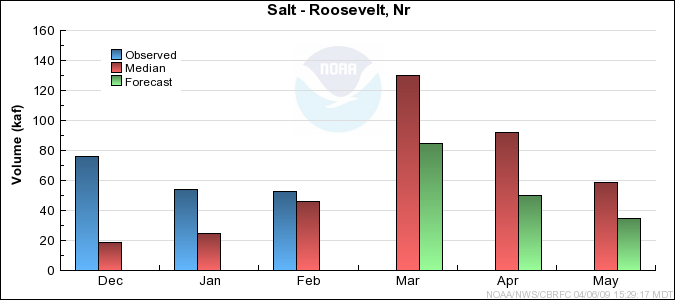
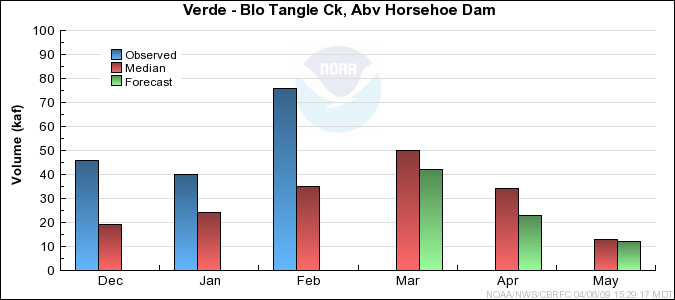

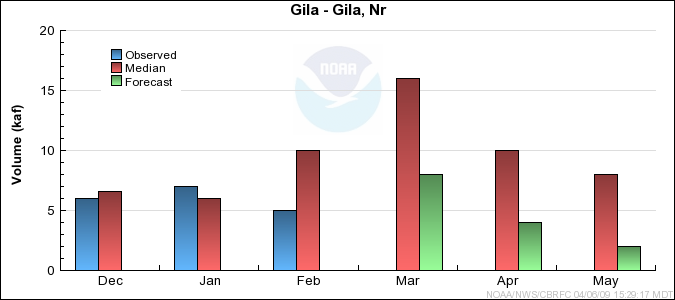
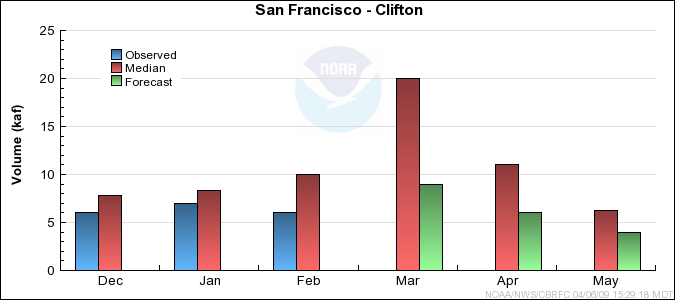

Precipitation Maps
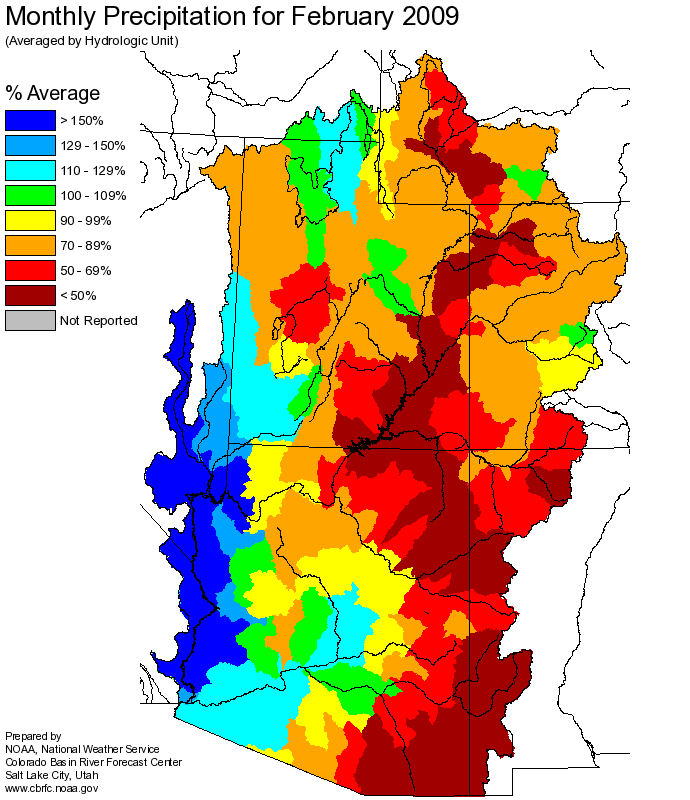
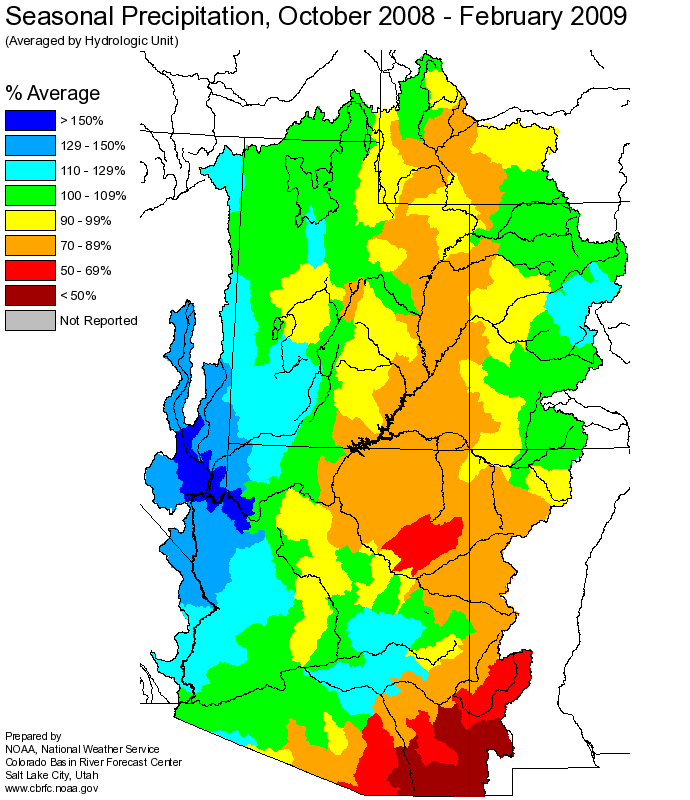
Hydrologist: G. Smith













